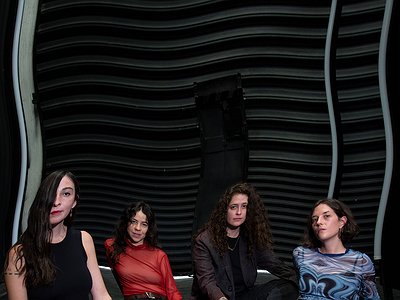Name: Amor Muere
Members: Mabe Fratti, Gibrana Cervantes, Concepción Huerta, Camille Mandoki
Occupations: Sound artists, composers, improvisers, instrumentalists
Nationalities: Guatemalan (Mabe Fratti), (Mexican (Gibrana Cervantes, Concepción Huerta, Camille Mandoki)
Current release: Amor Muere's A time to love, a time to die is out via Scrawl / FKA SA.
If you enjoyed this interview with Amor Muere and would like to stay up to date with the group and their music, visit them on Instagram. We also recommend our earlier Mabe Fratti interview.
What were some of your earliest collaborations? How do you look back on them with hindsight?
All of us started collaborating on Camille’s project in 2017. This was the first time we started exploring our sounds together, which led us to later begin playing as a band, outside of this first project.
We look back on it with a lot of love because during this time we could listen to all of our individual voices and we built a friendship that would naturally lead us to create Amor Muere.
There are many potential models for collaboration, from live performances and jamming/producing in the same room together up to file sharing. Which of these do you prefer – and why?
For us it is very obvious that we need to be in the same room together: We can have fun, make mistakes, cry, laugh, and listen to each other in real time.
What did you know about each other before working together? Describe your creative partner in a few words, please.
A mutual friend of ours led us to each other, he felt like we should meet.
It’s 4 of us so we could say what we have in common is that we are a little all over the place organizationally as well as emotionally.
What do you generally look for in a collaborator in general and what made you want to collaborate with each other specifically?
We all have a huge disposition and patience towards understanding what each of us is feeling and/or looking for.
We really appreciate openness and the exploration of sounds with each other.
Tell me a bit about your current instruments and tools, please. In which way do they support creative exchange and collaborations with others?
Both Mabe and Camille have the voice as one of their main instruments, Gibrana plays violin and pedals, Mabe also plays cello and pedals, Concepción uses tapes and synthesizers and Camille also plays electronic instruments. This exchange of acoustic and electronic sounds feel pretty complimentary for us.
But more important than the actual instruments is the way that we listen to the elements that each one brings and how we respond to each other.
Before you started making music together, did you in any form exchange concrete ideas, goals, or strategies? Generally speaking, what are your preferences when it comes to planning vs spontaneity in a collaboration?
We always start with a spontaneous approach. We will get together and talk about what’s going on in our lives and how we are feeling and maybe eat something yummy and then we will play spontaneously.
After that we might focus on the parts that we most enjoyed and practice them and sometimes structure them.
Describe the process of working together, please. What was different from your expectations and what did the other add to the music?
There is a lot of trust and there is no expectation, more of discovering.
Is there a piece which shows the different aspects you each contributed to the process particularly clearly?
“Love Dies” is quite evident in that way. In “Violeta y Malva,” though, you can really see how we begin an idea, the search or the exploration is quite evident in this one.
What tend to be the best collaborations in your opinion – those with artists you have a lot in common with or those where you have more differences? What happens when another musician takes you outside of your comfort zone?
We feel that the strengths in collaboration are mainly with the people who bring contrasting elements to your own, as is the case of our band as we all make very different music individually.
We have in common the fact that we like to explore sound in general, which is already getting out of our comfort zone.
Decisions between creatives often work without words. How did this process work in this case?
Actually yes, it is a lot about creating our environment before playing (talking, sharing, etc.) and then we stop talking and just make music.
What are your thoughts on the need for compromise vs standing by one's convictions? How did you resolve potential disagreements in this collaboration?
We always make time for any disagreement. It is not so much a democracy (where the majority makes the decisions), as us making sure that everyone comes to feel comfortable with each decision.
If there is one that disagrees, we make sure we get on the same page before solidifying a step.
Was this collaboration fun – does it need to be?
Yes! It must be.
Do you find that at the end of this collaboration, you changed certain parts of your process or your outlook on certain creative aspects?
Yes, always. It always brings something new to our individual process and to our other collaborations.
Collaborating with one's heroes can be a thrill or a cause for panic. Do you have any practical experience with this and what was it like?
It feels like a potential learning experience and a joy to be able to work with and learn from people we admire.




